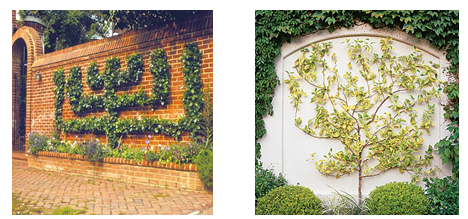Authors: Babita Singh, Prativa Anand and Ritu Jain
ICAR- Indian Agricultural Research Institute, Pusa, New Delhi
Espalier refers to the training of a plant or tree to grow flat against a wall or trellis. Espalier has considerable merit in today's garden design. The practice was originally used in the old world to conserve space in small orchards and gardens. Today, espaliers are used for introducing a decorative accent in the landscape the espalier plant is very definitely favored when the plot of ground is narrow, against wall or fences. This method of growing shrubs and trees is certainly decorative and conserves space. The word espalier is French, and it comes from the Italian spalliera, meaning "something to rest the shoulder (spalla) against". During the 17th Century, the word initially referred only to the actual trellis or frame on which such a plant was trained to grow, but over time it has come to be used to describe both the practice and the plants themselves. The practice was popularly used in the middle ages in Europe to produce fruit inside the walls of a typical castle courtyard without interfering with the open space and to decorate solid walls by planting flattened trees near them. Vineyards have used the technique in the training of grapes for hundreds or perhaps even thousands of years.

An espalier becomes a living sculpture in the garden. In landscape designs, we use espaliered plants and trees to cover unsightly, boring, or blank, windowless walls in the landscape. Espalier can bring an otherwise boring wall to life. We also use espalier between widely spaced windows to add height in the foundation planting. Also, there are often tight, confined areas where spreading shrubs or trees cannot be effectively maintained to stay within the confines, but an espalier will fit. With landscape spaces becoming smaller around the single family house, espaliered plants have considerable appeal.
Why we go for espalier
¨ It’s a space saving technique.
¨ Espaliered tree bear earlier and heavier than natural tree.
¨ Espalier tree remain healthier than natural tree.
¨ From an aesthetic point of view an espaliered fruit tree becomes a piece of landscape sculpture.
STEPS FOR CREATING ESPALIERS:
- Designing and Plant Selection
Pyracantha
— Camellias
— Flowering crabapples
— Witch hazels
— Creeping fig
— Junipers
Flowering quince etc. can be espaliered—
- Installation and Maintenance
Suitable established healthy plants, three to four feet tall in perhaps three-gallon containers are available from most nurseries. Some may even have trellises already installed and these could also be good candidates for espalier treatment, if their form is similar to the intended design as they frequently have already been pruned into a flattened overall plant shape and finally transplanted. The root ball of a plant should be planted 6-10 inches or more away from a wall to allow room for roots to grow and to provide adequate air circulation. Lean plant towards wall when planting. Follow instructions in planting a shrub or a tree for proper installation.
Unpruned plants benefit from being allowed to become well established following transplant, before pruning them gradually into their flattened profile and training them as designed. Any major pruning needed is generally accomplished either while the plant is dormant, or for flowering plants, during the proper season for pruning that species. Bending and training of the limbs that will remain in the design is done during the progression of the summer season when they are most flexible.
- Support
- Training & Pruning
There are numerous patterns from which to select. These range from the formal checker-board patterns to the simple informal natural growth spread. Almost any design can be worked out with proper pruning. Remember though, the simpler the design, the easier the maintenance. To maintain an espalier, remove all stray branches that appear vertical; growing out from the flat surface and beyond the boundaries of the desired pattern. Pruning and the occasional tying of new shoots to the surface of the wall are the main maintenance jobs. Most of the major pruning should be done while the plant is dormant, or if it is a flowering plant, be sure to prune in the appropriate season. Most flowering shrubs and trees should be pruned just after they bloom except for ones like crape myrtles which should be pruned in February or March. Remember that pruning does stimulate more growth. The limbs are most flexible during the summer. One can bend and train them to supports as the season progresses. Once established, the espalier tree or shrub requires only a small amount of maintenance each season, yet it contributes year-round distinction to the garden. A plant which has been espaliered correctly is a real work of art. Patience, skill, and creativeness are necessary for a successful project.
About Author / Additional Info:
I am working as a scientist